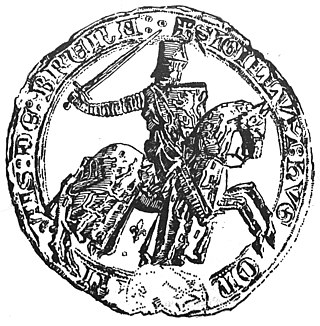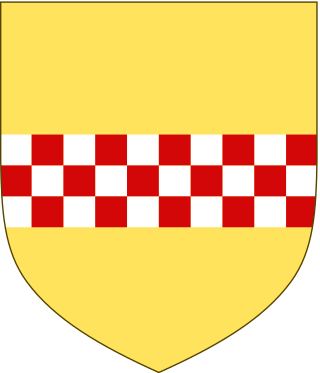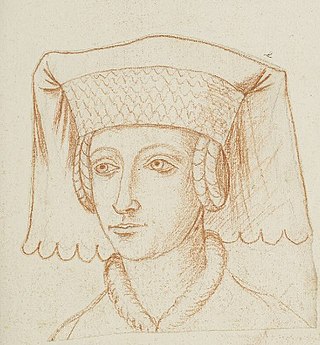The County of Brienne was a medieval county in France centered on Brienne-le-Château.
Contents

The County of Brienne was a medieval county in France centered on Brienne-le-Château.


Walter VI of Brienne was a French nobleman and crusader. He was the count of Brienne in France, the count of Conversano and Lecce in southern Italy and claimant to the Duchy of Athens in Frankish Greece.
During the late Middle Ages, the two cities of Argos and Nauplia formed a lordship within the Frankish-ruled Morea in southern Greece.

The Constable of France was lieutenant to the King of France, the first of the original five Great Officers of the Crown and the commander-in-chief of the Royal Army. He was, at least on paper, the highest-ranking member of the French nobility.
Isabella of Brienne (1306–1360) was suo jure Countess of Lecce and Conversano, claimant to the Duchy of Athens and Kingdom of Jerusalem, etc.

Hugh, Count of Brienne and Lecce was the second surviving son of Count Walter IV of Brienne and Marie de Lusignan of Cyprus.

Louis of Enghien titular Duke of Athens, Count of Brienne and Lord of Enghien in 1381–1394, Count of Conversano in 1356–1394.

This is a list of the counts of Eu, a French county in the Middle Ages.

The House of La Marck was a noble family, which from about 1200 appeared as the counts of Mark.

The Count of Hainaut was the ruler of the county of Hainaut, a historical region in the Low Countries. In English-language historical sources, the title is often given the older spelling Hainault.
Erard I, Count of Brienne (1060–1114) was Count of Brienne at the end of the 11th century. He was the son of Walter I of Brienne, count of Brienne, and his wife Eustachie of Tonnerre(Eustachie de Tonnerre).
Erard of Brienne may refer to:
Margaret of Baux was a Countess of Saint-Pol, of Brienne, and of Conversano. She was a member of the noble House of Baux of the Kingdom of Naples, which had its origins in Provence dating back to the 11th century. Her husband was Peter of Luxembourg, Count of Saint-Pol, of Brienne, and of Conversano.
Jeanne de Bar, suo jure Countess of Marle and Soissons, Dame d'Oisy, Viscountess of Meaux, and Countess of Saint-Pol, of Brienne, de Ligny, and Conversano was a noble French heiress and Sovereign Countess. She was the only child of Robert of Bar, Count of Marle and Soissons, Sire d'Oisy, who was killed at the Battle of Agincourt when she was a baby, leaving her the sole heiress to his titles and estates. In 1430, at the age of fifteen, Jeanne was one of the three women placed in charge of Joan of Arc when the latter was a prisoner in the castle of John II of Luxembourg, Count of Ligny, Jeanne's stepfather.

Henri-Auguste de Loménie, Count of Brienne, Seigneur de La Ville-aux-Clercs was a French politician. He was secretary of state for the navy from 1615 to February 1643, and then secretary of state for foreign affairs from 1643 to 1663 under Mazarin during the minority of Louis XIV. From the Loménie family, he was the son of Antoine de Loménie, secretary of state to Henry IV and a Huguenot convert.

Marguerite d'Enghien, was the ruling suo jure Countess of Brienne and of Conversano, suo jure Lady of Enghien, and Lady of Beauvois from 1394 until an unknown date.

Peter of Luxembourg was count of Saint-Pol. His inheritance included the counties of Brienne, Conversano and Saint-Pol.
Guy I of Luxembourg-Ligny was Count of Saint-Pol (1360–1371) and Count of Ligny, Lord of Roussy and Beauvoir (1364–1371).

John of Luxembourg, was Lord of Beauvoir and Richebourg, and also Count of Brienne and Conversano.
Walter I of Brienne, was a count of Brienne and Bar-sur-Seine. He was the son of Engelbert IV of Brienne, count of Brienne, whom he succeeded. He attended the council of Senlis in 1048 and was excommunicated in 1082.
48°23′N4°32′E / 48.39°N 4.53°E